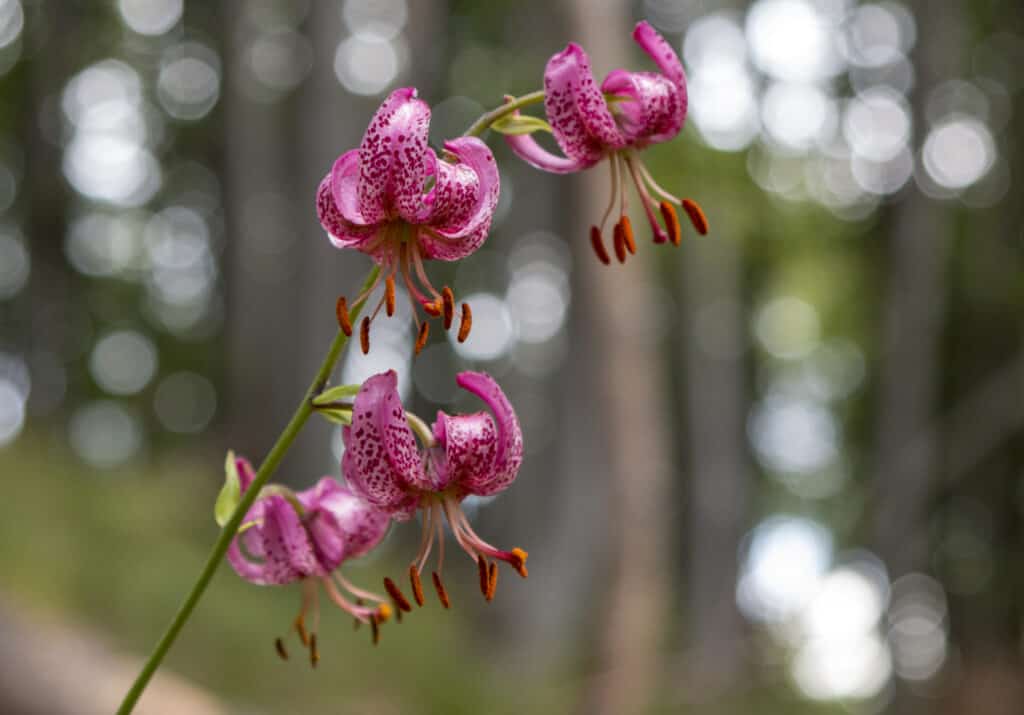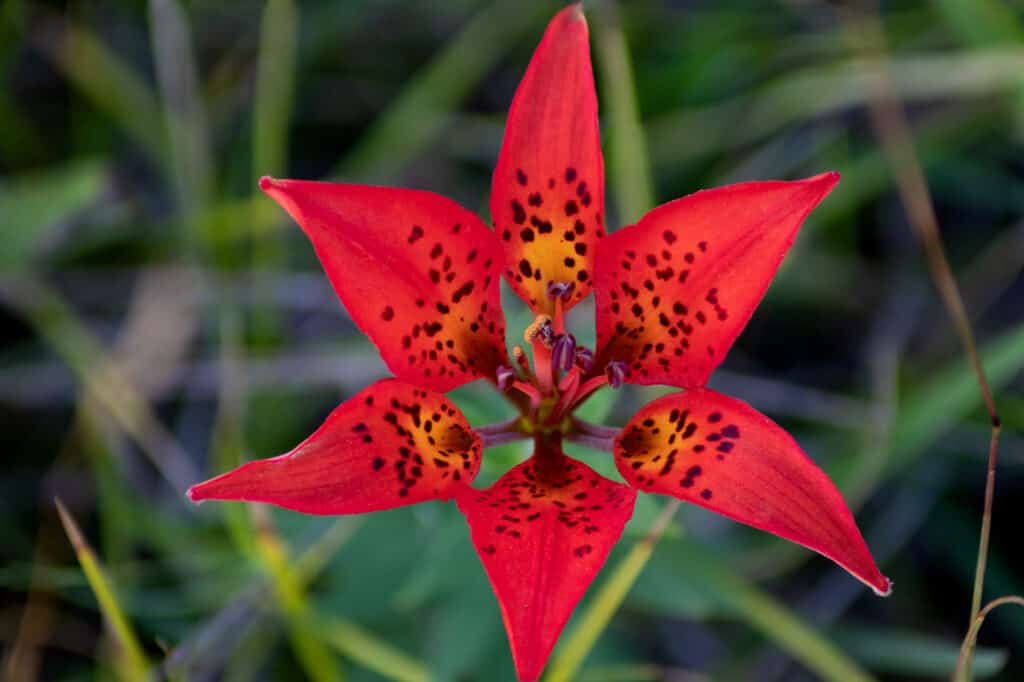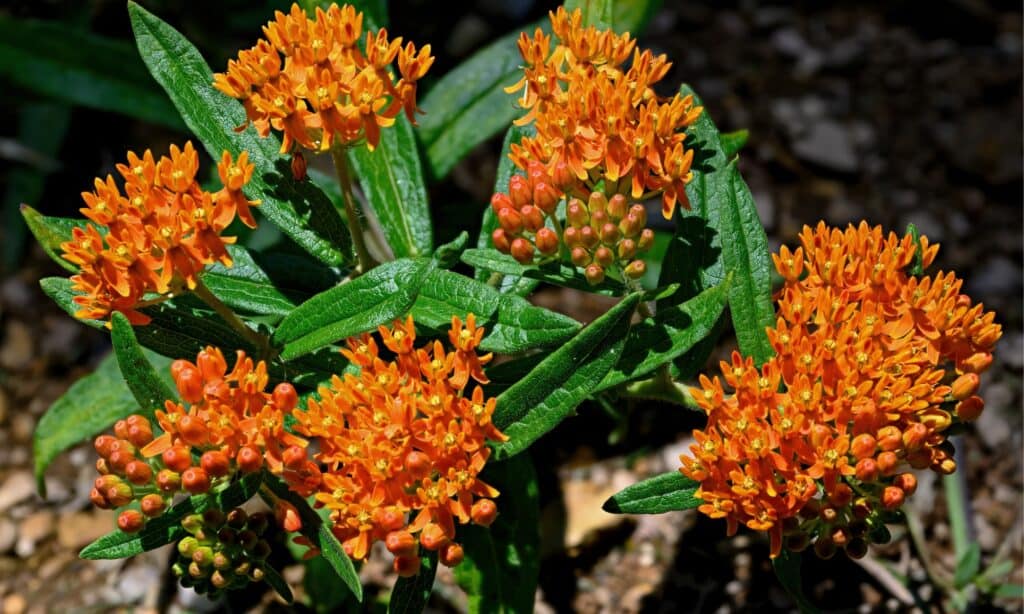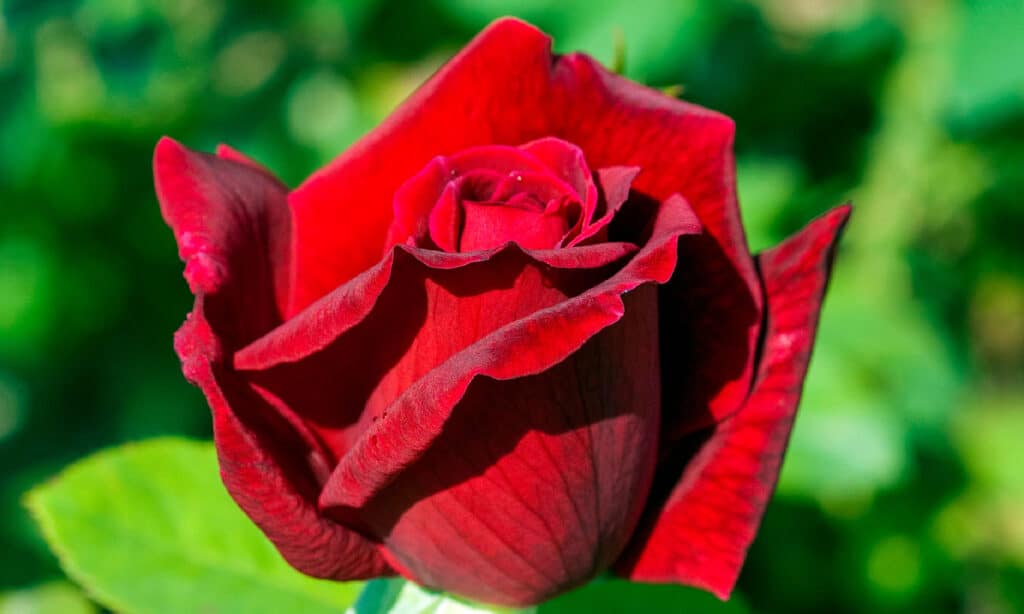Red bee balm has delicate cherry petals. It’s one of the best red perennial flowers. It was popular among the Oswego Indians. They would steep the leaves in steaming hot water. The tea is said to have made them feel whole and sound inside. Perhaps that’s how hummingbirds feel after sipping the plant’s delicious nectar. Anyone who’s ever used bee balm to relieve pain from bee stings also appreciates what these red tubular flowers offer.
Native to Georgia and Tennessee, you can find red bee balm throughout the United States. They bloom from June to August and can reach heights of 3 to 5 ft tall! But what other red perennials should you know about? Read on to learn about a few of the best wild red perennials you can plant yourself.
1. Turk’s-Cap Lily

The Turk’s cap lily can produce as many as 50 blooms on one plant.
©iStock.com/Gerdzhikov
Proud tall stocks with impressive whorls of leaves, the petals of each flower are curvy with a deep green base. Melding into yellow, then orange and spotted all over, the spirited tips of Turk’s-cap lily are scarlet red. They’re breathtaking red perennial flowers.
Fascinating Facts
Turk’s cap lily (Lilium Superbum) can produce as many as 50 blooms on one plant. It’s a sight to behold. The flowers are pendants. But that doesn’t stop the seeds from spreading with the help of the wind.
Once they’re ready to take flight, the flower capsules split along the sides, freeing the seeds into the breeze. They don’t usually travel far before taking root somewhere else.
Natural Habitat
You’ll find Turk’s cap lily throughout swamps and wet meadows. They’re native to Southern Canada. If you get a chance to see these flowers in the wild, they might be as tall as you! This upright perennial can grow 4 to 8 ft tall and blooms between July and August. To thrive, it needs partial shade and rich organic soil. The best soil will have a lot of moisture to keep these tall perennials hydrated.
Gardening Tips
Suppose you want to decorate your backyard with gorgeous red perennial flowers of the Turk’s-cap variety. In that case, plant each bulb 48 below the soil surface. Protect the bulbs from the wind with steaks, and be sure to mulch in the summer. Consistent mulching will keep the soil nice and moist, and these flowers love water. Sometimes diseased plants will have flattened stems. Remove these from your garden after confirming they’re unhealthy.
2. Wood Lily

The wood lily is well known among wildflower enthusiasts worldwide.
©iStock.com/Corey T. Burns
It won’t be easy to look away from the gorgeous upright blossoms staring you straight. Unlike other wild lilies, wood lily prefers to face straight up. The red-orange flowers have deep dark spots inside.
Fascinating Facts
Wood lily (Lilium philadelphicum) is well known among wildflower enthusiasts worldwide. You would think with the name wood lily that these flowers are abundant throughout the forest. But that’s not the case. It’s a rare sight to see a group of these wild lilies standing among the trees. When they get lucky, the flowers are pollinated by tiger swallowtail butterflies as the butterflies reach for sips of nectar, and bits of pollen stick to the tips of their wings.
Natural Habitat
For the best luck finding wood lilies in their natural habitat, you’ll want to look throughout Meadows and woodland clearings. They’re native to Southern Canada, North Carolina, and Nebraska. These red perennials can grow to be anywhere from one to three feet tall and bloom between June and July. To reach their full potential, wood lilies need partial shade and average moisture.
Gardening Tips
Are you going to be adding wood lilies to your garden? Plan on planting them in the spring or fall. Plant each bulb at least 4 to 5 in into the soil. They can propagate at the end of the summer by detaching the small bulbs from the main bulb. You can easily buy with lilies or dig them up for yourself in the wild. If you’re going to buy them, make sure that their nursery is propagated.
3. Butterfly Weed

Butterfly weed is particularly great for attracting large adult butterflies.
©iStock.com/McKinneMike
Hairy leaves? Yes, this tall narrow perennial has hairy leaves and adorable clusters of bright red flowers. The tips of each stem feature a beautiful bloom, and sometimes yellow flowers sneak into the mix. There isn’t any milky juice in the stems of butterfly weed, but it’s still a great plant for attracting adult butterflies.
Fascinating Facts
Butterfly weed (Asclepias tuberosa) is particularly great for attracting large adult butterflies. The flowers are full of savory nectar. Each bunch of red blossoms is just waiting for a butterfly to come and take a sip.
If you want to see something fascinating, take a moment to look closely at the stems of the butterfly weed plant. Do you see small bags of pollen? That means that when the butterfly came in to take a sip, a bit of the pollination stuck to their feet. You’re looking at butterfly tracks–neat!
Natural Habitats
Sandy dry areas are the best places for finding butterfly weeds in the wild. They’re native to the Gulf of Mexico and Southern Canada. Going to be one to three feet tall, these red perennials bloom between June and September. To reach their full height, butterfly weed plants need full sun and low moisture.
Gardening Tips
Best grown from seeds, one of the best pieces of advice for taking care of butterfly weed plants is to leave them alone. After they establish themselves in your environment, don’t mess with them. These plants don’t need a lot of water, and without proper drainage, the roots will rot. If the plant is driving, then it’s already found its ideal moisture environment. Leaving it alone will mean you get to just enjoy it and see lots of butterflies (and bees).
4. Red Rose

The red rose is associated with love and appreciation.
©iStock.com/emer1940
While not a wildflower, red roses are still the perfect addition to any garden. A classic flower that needs no introduction, the red rose is associated with love and appreciation. These thorned beauties come in many shades of red, from crimson to orange-red. They’re ideal for adding a touch of elegance to any space.
Fascinating Facts
The classic red rose is a hybrid of two other roses, Rosa Gallica and Rosa Foetida. This hybrid was first cultivated in China over 5,000 years ago!
Natural Habitat
Roses are native to Asia and Europe but can now be found all over the world. They prefer full sun and well-drained soil.
Gardening Tips
To grow the perfect red rose, start by planting the bush in early spring. Give it plenty of room to grow, as roses can get quite large. Be sure to water regularly and fertilize monthly during the growing season. You can also deadhead the flowers to encourage new growth.
Up Next:
The photo featured at the top of this post is © RussieseO/Shutterstock.com
Sources
- Gardening Almanac, Available here: https://www.almanac.com/plant/roses
- Garden Tabs, Available here: https://gardentabs.com/red-perennials-that-bloom-all-summer/
- Home Depot, Available here: https://gardentabs.com/red-perennials-that-bloom-all-summer/
- Jason White, Available here: https://www.allaboutgardening.com/red-perennial-flowers/
Thank you for reading! Have some feedback for us? Contact the AZ Animals editorial team.






